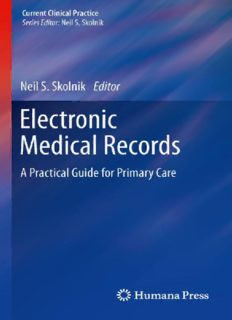
Electronic medical records: A practical guide for primary care PDF
Preview Electronic medical records: A practical guide for primary care
Current Clinical Practice SeriesEditor NeilS.Skolnik TempleUniversity,SchoolofMedicine,AbingtonMemorialHospital, Abington,PA,USA Forfurthervolumes: http://www.springer.com/series/7633 Neil S. Skolnik Editor Electronic Medical Records A Practical Guide for Primary Care Editor NeilS.Skolnik AbingtonMemorialHospital TempleUniversitySchoolofMedicine Abington,PA,USA [email protected] ISBN978-1-60761-605-4 e-ISBN978-1-60761-606-1 DOI10.1007/978-1-60761-606-1 SpringerNewYorkDordrechtHeidelbergLondon LibraryofCongressControlNumber:2010936461 ©SpringerScience+BusinessMedia,LLC2011 Allrightsreserved.Thisworkmaynotbetranslatedorcopiedinwholeorinpartwithoutthewritten permissionofthepublisher(HumanaPress,c/oSpringerScience+BusinessMedia,LLC,233Spring Street,NewYork,NY10013,USA),exceptforbriefexcerptsinconnectionwithreviewsorscholarly analysis.Useinconnectionwithanyformofinformationstorageandretrieval,electronicadaptation, computer software, or by similar or dissimilar methodology now known or hereafter developed is forbidden. Theuseinthispublicationoftradenames,trademarks,servicemarks,andsimilarterms,eveniftheyare notidentifiedassuch,isnottobetakenasanexpressionofopinionastowhetherornottheyaresubject toproprietaryrights. Whiletheadviceandinformationinthisbookarebelievedtobetrueandaccurateatthedateofgoing to press, neither the authors nor the editors nor the publisher can accept any legal responsibility for anyerrorsoromissionsthatmaybemade.Thepublishermakesnowarranty,expressorimplied,with respecttothematerialcontainedherein. Printedonacid-freepaper HumanaPressispartofSpringerScience+BusinessMedia(www.springer.com) Preface Itisnotthestrongestofthespeciesthatsurvive,northemostintelligent,buttheonemost responsivetochange. –CharlesDarwin A virtually awe inspiring idea which becomes the dream of one generation often becomestherealityofthegenerationtocome.Attheturnofthetwentiethcentury theUnitedStateshad20millionhorsesand4000cars.Gasoline,whichwasawaste product of the kerosene needed for lamps, was carried in buckets by automobile enthusiastsfromwhateversourcetheycouldfind.Overthenextdecade,aseriesof watershed events rapidly transformed the car from a novelty to a useful device. In 1903,HoratioNelsonJacksonsuccessfullydroveanautomobileacrosstheUnited States, demonstrating the value of the car as transportation. In 1905, Sylvanus F. Bowserperfectedthegasolinepump,andtheworld’sfirstfillingstationopenedlater thatyear.Thenin1908,FordMotorCompanybeganmassproductionoftheModel T.Coupledwithatimeofprosperity,theautomobilebecamealifestyle,availableto peopleofevenmodestmeans. By1910,therewerehalfamillioncarsinuseintheUnitedStates.Unfortunately, breakdowns were still frequent, fuel was still difficult to obtain, and rapid inno- vation meant that even a 1-year-old car was nearly worthless. The high-wheeled buggy style, directly descendent from the horse-drawn buggy of the previous cen- tury,couldbedrivenvirtuallyanywhere.Thiswasnecessary,sincetherewereless than 200,000 miles of gravel road and only 1000 miles of paved concrete. It was not for yet another decade, in 1921, that the Federal Highway Act was passed by Congress.ThiswaslegislationthatcoordinatedstatehighwaysandstandardizedUS roadconstructionpractices.Nowacenturylater,wearetheproudownersofabout 5.7millionmilesofpavedhighway,alongwithabout125,000gasstations. How is this progression of technology, culture, and infrastructure relevant? At anyresponsibleorganizationnewthingsareregularlyintroduced.Despitedecades of tinkering, electronic medical record (EMR) systems remain a relatively novel technology.TheDesRochesdata(seeChapter1)showedthatasof2008,only4% ofambulatoryphysicianswereusingafullEMR,withonlyanadditional13%using apartialsystem.Thereareadizzyingnumberofmodels,andtheycanbetakenin v vi Preface almostanydirection(evenoff-road).Featurescanbecomequicklyobsolete,andthe governmenthasjustbegunsettleonnationalstandardsfortheiruse.Perhapsmost importantly,theentireculturaltransformationthatattendsnewtechnologiesisonly justemergingforEMRs. Physicianshavemanyconcerns.Willthistechnologyinterferewiththehuman- ism and patient interactions that form the heart and soul, if not the science, of medical care? Will the placement of a screen in the room divert the physician’s attention from the patient to filling out unnecessary forms and pieces of required data?Willthe“narrative”oftheillness,thedescriptionofthepatient’sexperience, belostastherepresentationofdiseaseisnarrowedtodiscretedatafields? In addition to these humanistic concerns are the more practical concerns sur- rounding the efficiencies of patient care and the enormous cost of integrating an EMRintoapractice.Acolleagueofours,KeithSweigart,focusedthisissuewhen, respondingtoaquestionabouttheefficiencyofEMRs,hecommented,“Remember, the most efficient care is sloppy care.” This observation clarified that efficiency, while often discussed and certainly important, cannot be the sine qua non of the electronic medical record. The old practitioner who kept sparse notes about his patients on 3 by 5 inch cards gave humanistic, efficient care; however, the way that practitioner documented his care would never suffice for the complexity of modern medical care, or for the collaborative care that is now necessary in any grouppractice.Asmedicalknowledgebecomesmorecomplex,itwillbecomeever moreimportanttohaveprimarycarephysiciansprovidingthemajorityofcarefor patients,anditwillbecomeincreasinglynecessarytohavesystemsthatcoordinate a patient’s care among all providers. In order to do this, EMRs will need to easily recordandtransmitmedicalinformationinaclear,predictable,andsecurefashion betweendifferentpractitioners. OneofthegreatpotentialbenefitsofEMRsystemsispopulationmanagement. Ourcurrentsystemofpaper-basedindividualmedicalrecordsrequiresthataphysi- cianwaituntilapatientcomestotheofficebeforetheopportunityarisestointercede on chronic disease processes. Moreover, the effort to manage risk is often com- promised if that patient comes in with another agenda, if they were scheduled for insufficienttime,orifthedayhasbecomeparticularlybusy.EMRsprovideamethod wherebywecanthoughtfullyfindthosepatientswhohavesub-optimalmanagement andreachouttothemproactively. Throughtheuseofpatientportals,EMRsmayadditionallybeabletoencouragea morecollaborativehealthsystemwithourpatients,whoultimatelyhavethegreatest stake in their health care. Patients can access their records and results, dwell over them,anddiscusswithothershowtheymightaddresstheirconcerns,inawaynot allthatdifferentfromwhatweasphysiciansdoduringpatientcareconferences. Increasingly our method of recording information, in an electronic medical record, will force us to pay more and more attention to the content of the infor- mation we gather. With this attention to content it is important for us to also keep ourfocusonthesimplefactthattheprocessofgatheringinformationandforming relationshipswithourpatientshasinherentvalue.Donecorrectly,withempathyand attentiontodetail,thisprocessmakesbothpatientandphysicianfeelmoresatisfied Preface vii with the interaction and also affects health outcomes. The relationship that devel- opsbetweenaphysicianandapatienthasadirecttherapeuticeffect,influencesthe information obtained, the decisions about what treatments a patient will consider, compliancewithmedicationsandlifestylemodification,andkeepsthedooropenso thatpatientsarecomfortablereturningforfollow-up. TheissuessurroundingEMRswillnotberesolvedquickly,oreasily.Technology mustco-evolvewithtechnique,alongwiththeculturalexpectationsofpatientsand physicians. With humanism sustained as the basis of medical care, and with tech- nology enabling the best use of evidence-based medical science, we will improve patientcareforindividualsaswellasthepopulation. Abington,Pennsylvania NeilS.Skolnik Leonardtown,Maryland ThomasM.Wilkinson Acknowledgements Books do not grow quickly. They have a gestation period that is rivaled only by elephantsandbluewhales.Nordobooksdevelopinavacuum;theyareinfluenced bytheirenvironmentandareoftenfacilitatedbythediscussions,support,andinput ofothers.Ifeelfortunatetoworkinanenvironmentfilledwithcolleagueswhoover the years have also become close friends – Mat Clark, Amy Clouse, Trip Hansen, PamFenstemacher,andJohnRussell–wherewehelp,criticize,compliment,joke, challenge, and ultimately support one other in a way that characterizes and role modelsforourresidentsthebestaspectsofahealthyworkenvironment.Thisiswhy, for over 20 years, we continue to have one of the best family medicine residency programs in the region, perhaps in the country, combining core clinical medicine with strong academics and training individuals who go on to become some of the bestfamilydoctorsinourtri-statearea.Aprogramlikethis,thatseespatientsfrom allbackgroundsregardlessoftheirabilitytopayinanenvironmentofsupportand respect,canonlyoccurwhensupportedstronglybyaparenthospitalandthepeople in charge of that hospital – Jack Kelly, Meg McGoldrick, and now Larry Merlis – individuals committed to doing the right thing for the patients in our community, andKeithSweigartwholedtheAbingtonMemorialHospitalsearchandlaunchof anelectronichealthrecord. No plant, no person, and no book grows to its best and fullest without the love andsupportoffamily.Isavethemostimportantacknowledgementsforlast,because mylastthoughtseachdayandmyfirstthoughtseachmorningareaboutmyfamily –alwayslivingI’veslowlyonlynoticedthemostimportantthingsinlife–mywife Alison,whoIloveandwithwhomItraveltogetherdownthiswonderful,confusing, cascadingriveroflife;mydaughterAva–whoisadelightandwhosesingingIhear eveninmysleep;andmyson,Aaron–withwhomIhavesharedthegreatestfishing adventuresofalifetime. NeilS.Skolnik ix
Description: